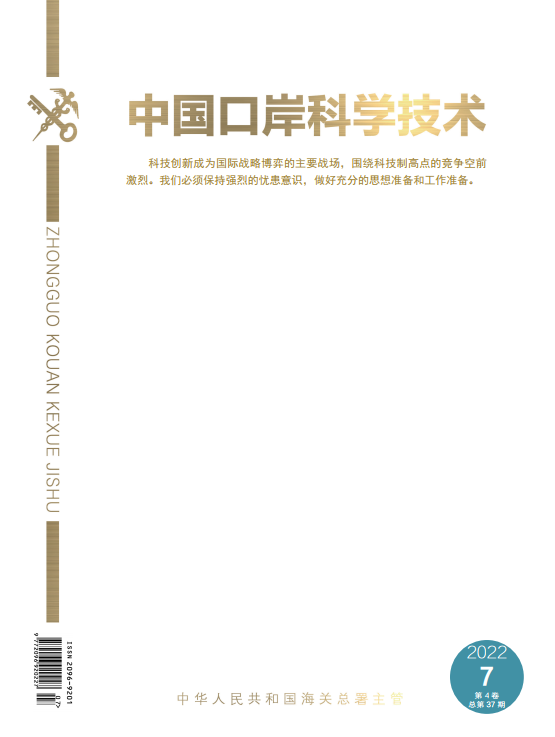CopyRight 2009-2020 © All Rights Reserved.版权所有: 中国海关未经授权禁止复制或建立镜像
湛江口岸进口冻虾携带病毒检测发现与分析
作者:李家侨1 谢艳辉1 李家婵2 斯泽恩1 唐媛媛1 郑舒尹1 张 娜1*
李家侨1 谢艳辉1 李家婵2 斯泽恩1 唐媛媛1 郑舒尹1 张 娜1*
摘 要 为了解印度、厄瓜多尔进口冷冻虾病原携带情况,掌握进口冻虾的疫情动态,为监控部门提供科学依据,对2019—2020年中301批进口冻虾进行WSSV、IHHNV、YHV、TSV和IMNV病原体检测,其中印度254批、厄瓜多尔47批。进口冻虾中WSSV的阳性率为23.92%,IHHNV的阳性率5.65%,WSSV和IHHNV共感染阳性率1.66%,而YHV、TSV、IMNV均没有检出。其中来自印度的冻虾中,WSSV阳性率达26.77%,IHHNV阳性率1.97%,WSSV和IHHNV共感染率是1.66%;来自厄瓜多尔的冻虾中,WSSV的阳性率8.5%,IHHNV的阳性率达25.53%,WSSV和IHHNV的共感染率8.5%。根据冻虾的形态分析结果显示,冻虾仁中WSSV的阳性率达25.6%,IHHNV的阳性率1.45%;带头带壳的冻虾中,WSSV的阳性率达20.21%,IHHNV的阳性率达14.99%,WSSV/IHHNV的阳性率是5.32%。结果提示,印度的冻虾主要以感染WSSV为主,厄瓜多尔主要以感染IHHNV为主,带头带壳的冻虾WSSV和IHHNV的阳性率都很高,因此亟须加强对进口冻虾产品的管控力度,防止给我国对虾养殖业造成潜在的传播风险。
关键词 冻虾;WSSV;IHHNV;印度;厄瓜多尔;分析
Detection and Analysis of Virus Carried by Imported Frozen Shrimp at Zhanjiang Port
LI Jia-Qiao1 XIE Yan-Hui1 LI Jia-Chan2 SI Ze-En1 TANG Yuan-Yuan1 ZHENG Shu-Yin1 ZHANG Na1*
Abstract In order to understand the pathogenic status of imported frozen shrimps from India and Ecuador, grasp the epidemic situation of imported frozen shrimps, and provide scientific basis for monitoring authorities, 301 batches of imported frozen shrimps from 2019 to 2020 were tested for WSSV, IHHNV, YHV, TSV and IMNV pathogens, among which 254 batches were imported from India and 47 batches were imported from Ecuador. Results: the positive rate of WSSV was 23.92%, the positive rate of IHHNV was 5.65%, and the positive rate of co-infection WSSV and IHHNV were 1.66%,and YHV, TSV, IMNV could not detected. Among the frozen shrimp from India, the positive rate of WSSV was up to 26.77%, the positive rate of IHHNV was 1.97%, and the positive rate of of co-anfection WSSV and IHHNV ware higher1.66%; in the frozen shrimp from Ecuador, the positive rates of WSSV was 8.5%, the positive rates of IHHNV was 25.53% , and the positive rate of of co-infection WSSV and IHHNV ware 8.5%. According to the morphological analysis of frozen shrimp, the positive rate of WSSV was 25.6%, the positive rate of IHHNV 1.45%; the positive rates of WSSV, IHHNV and WSSV/IHHNV were 20.21%, 14.99% and 5.32% respectively in the head and shell frozen shrimp. The results suggested that frozen shrimps in India were mainly infected with WSSV, while in Ecuador, they were mainly infected with IHHNV. The positive rate of WSSV and IHHNV of frozen shrimp with head and shell is very high.It was necessary to strengthen the control of imported frozen shrimp products to prevent the potential transmission risk of imported frozen shrimp to China's shrimp breeding industry.
Keywords frozen shrimp; WSSV; IHHNV; India; Ecuador; risk
白斑综合征病毒(White spot syndrome virus,WSSV)是OIE 一类疫病传染病,是对虾主要病原体,死亡率高,在无特定病原体(SPF)的虾中短短几天能达到100%的死亡率,已经成为全球对虾养殖行业的巨大威胁,在世界范围内造成重大的经济损失。白斑综合征1992年首次在我国台湾报道,随后在日本、韩国、东南亚、南亚、地中海、中东、美洲和澳大利亚陆续报道[1]。WSSV风险主要发生在进口受感染的虾,活虾、冷冻虾、带头虾、带壳虾、无头虾或者熟虾都有传播风险。对虾传染性皮下及造血组织坏死病(Infectious hypodermal and haematopoietic necrosis virus, IHHNV),1980年首次在美国夏威夷细角滨对虾中发现[2-3],随后在凡纳滨对虾[4]、斑节对虾[5]、罗氏沼虾[6]等都有检出。IHHNV已经成为了全球对虾养殖业最流行的病原体之一,该病不会引起南美白对虾和斑节对虾死亡,但是会造成对虾生长缓慢,给对虾养殖户造成重大经济损失[6-9]。除了WSSV和IHHNV,黄头病毒(YHV)、传染性肌肉坏死病毒(IMNV)、桃拉病毒(TSV)等对对虾养殖的影响也很大,均属于OIE一类水生动物疫病。
湛江地区每年会从国外进口大量的冷冻虾,进口国家主要集中在印度和厄瓜多尔。进口的冷冻虾形态不一,有带头带壳完整的虾,也有去头去壳的虾仁。目前国内外对养殖场中凡纳滨对虾的感染病原体的报道较多,但是冷冻虾携带病原体的报道较少,尤其是不同国家、不同形态的冷冻虾携带病原体的情况还未见报道,通过对进口的冷冻虾病原体的持续监测,为进口冷冻虾质量安全和风险监控提供科学的数据参考。
1 材料与方法
1.1 试剂
引物由TAKARA宝生物合成;Taq酶购自TAKARA。
1.2 材料
2019—2020年,湛江口岸共进口或检测301批冷冻南美白对虾,254批来自印度,47批来自厄瓜多尔。其中,带头带壳虾有94批,去头去壳的虾仁有207批。
1.3 取样
去头去壳的虾仁,取虾肉;带头带壳的冷冻虾,同时取腮和肉。
1.4 核酸提取
每个样品约取100 mg,加1 mL PBS,加钢珠,用匀浆仪匀浆,在12000 rpm转速下,离心2 min,留上清,然后采用gMAXTM-96 VIRAL RNA ISOLATION KIT(货号为AM1836) 试剂盒方法,提取总核酸,用于分子生物学检测。
1.5 PCR检测
WSSV采用OIE《水生动物疾病诊断手册》2019版2.2.8中巢式PCR方法,扩增片段分别为 1447 bp和941 bp,扩增引物见表1。IHHNV采用OIE《水生动物疾病诊断手册》2019版2.2.4方法,根据OIE推荐的引物,先用389F/R检测所用样品,检出的阳性样品,再用309F/R和MG831F/R两套引物进行分型,其中309F/R检测IHHV1型和2型(感染型),MG831F/R扩增3A型和3B型(非感染型)。YHV采用OIE《水生动物疾病诊断手册》2019版2.2.9方法,根据OIE推荐的引物,采用10F/144R进行检测。TSV采用OIE《水生动物疾病诊断手册》2017版2.2.7方法,根据OIE推荐的引物,用TSV F/R进行检测。IMNV采用OIE《水生动物疾病诊断手册》2017版2.2.5方法,根据OIE推荐的引物,用4587F/4914R引物,再用4725NF/4863NR进行检测。扩增引物见表1。
2 结果与讨论
2.1 冻虾病原体感染的总体概况
表1 OIE推荐用WSSV、IHHNV、YHV、TSV和IMNV的引物序列和PCR反应条件
Table 1 Primers of WSSV、IHHNV、YHV、TSV and IMNV recommended by OIE
基因名称 | 引物序列 (5' -3') | 退火温度 (℃) | PCR产物 (bp) | |
WSSV | 146F1 | ACTACTAACTTCAGCCTATCTAG | ||
146R1 | TAATGCGGGTGTAATGTTCTTACGA | 55 | 1447 | |
146F2 | TAATGCGGGTGTAATGTTCTTACGA | |||
146R2 | TACGGCAGCTGCTGCACCTTGT | 55 | 941 | |
IHHNV | 389F | CGGAACACAACCCGACTTTA | ||
389R | GGCCAAGACCAAAATACGAA | 55 | 389 | |
MG831F | TTGGGGATGCAGCAATATCT | |||
MG831R | GTCCATCCACTGATCGGACT | 55 | 831 | |
309F | TCCAACACTTAGTCAAAACCAA | |||
309R | TGTCTGCTACGATGATTATCCA | 55 | 309 | |
YHV | 10F | CCGGTAATTTCAAAAACTACG | ||
144R | AAGGTGTTATGTCGAGGAAGT | 66 | 135 | |
TSV | TSVF | ATTGAATACTTAGCACAGCGACC | ||
TSVR | GAACACCACTACCATAGGGGAG | 58 | 295 | |
IMNV | 4587F | CGACGCTGCTAACCATACAA | ||
4914R | ACTCGGCTGTTCGATCAAGT | 60 | 328 | |
4725NF | GGCACATGCTCAGAGACA | |||
4863NR | AGCGCTGAGTCCAGTCTTG | 65 | 139 |
在进口的301批冻虾样本中, WSSV检出72批,IHHNV 检出17批,检出的IHHNV均为1型和2型感染型(表2)。部分冻虾检出WSSV和IHHNV的电泳图结果见图1、图2和图3。从结果看,进口冻虾的WSSV感染率非常高,达到23.92%,IHHNV的感染率是5.65%,而且出现WSSV和IHHNV同时感染的情况。而YHV、TSV、IMNV这3种RNA病毒病均没有检出,这有可能与这3种病毒在这些国家的流行率不高,另外病毒RNA不易于保存,在长期保存和运输过程中出现了降解,不易被检出。由于进口冻虾具有携带病原体的风险,为了降低传入风险,国际上不同国家对于进口冻虾的检测要求和处理办法不一样,有些国家不断提高冻虾进口标准甚至暂停进口。泰国因为在印度原料虾中检出传染性肌肉坏死病毒,就暂停进口印度的虾类产品[10] 。澳大利亚、沙特阿拉伯王国等一些国家对生虾/对虾产品的进口有严格的规定,对进口产品进行PCR反应筛选以确定是否存在某些病毒,如果批次出现阳性,则进行销毁或煮熟处理。澳大利亚为了防止WSSV给自己国家对虾养殖业带来潜在的风险,不断提高进口标准,要求进口的冻虾要剔除虾线,或者制成面包虾、熟虾,防止进口生虾给自己国家带来病原传入的风险。我国对于进口的冻虾,若检出阳性则选择退运或者煮熟的方法处理,防止冻虾病原体进入我国的对虾养殖业。已有研究[11]表明感染了WSSV的虾,在沸腾的温度下,把虾煮熟1 min,WSSV不具有感染风险,能有效防止WSSV潜在的传播风险。WSSV和IHHNV的阳性率高,为了保障国内对虾养殖业的健康发展,对于进口冻虾加强这两个病原体监测,成为重中之重。
表2 进口冻虾WSSV和IHHNV检出情况
Table 2 Detection of WSSV and IHHNV of imported frozen shrimp
病原 | 阳性(批) | 阳性率(%) |
WSSV | 72 | 23.92 |
IHHNV | 17 | 5.65 |
WSSV/IHHNV | 5 | 1.66 |

图1 部分冻虾样品WSSV PCR检测结果
Fig.1 WSSV PCR detection results for some frozen shrimps

图2 部分冻虾样品IHHNV 389bp PCR检测结果
Fig.2 389bp IHHNV PCR dection results for some frozen shrimps

图3 部分冻虾样品IHHNV 309bp PCR检测结果
Fig.3 IHHNV 309bp PCR detection results of some frozen shrimp samples
2.2 根据来源国不同进行分析
印度和厄瓜多尔是对虾养殖大国,每年中国都从这两个国家进口冻虾。此次对印度254批和厄瓜多尔47批的冻虾进行病毒检测,均检出WSSV和IHHNV(表3),其中印度WSSV的携带率高达26.77%,厄瓜多尔的IHHNV的携带率高达25.53%,而且厄瓜多尔WSSV和IHHNV共感染的情况达8.5%。印度的冻虾以感染WSSV为主,而厄瓜多尔以感染IHHNV为主。据报道,2019年厄瓜多尔和印度是中国进口南美白对虾数量第一和第二的国家,中国全年进口冷冻对虾的数量超过了40万吨,是全球最重要的对虾进口市场之一。其中印度养殖的南美白对虾40%是出口到中国市场。厄瓜多尔养殖的南美白对虾到中国的出口量也呈不断增长的趋势,约占出口总量的55%。由于对印度和厄瓜多尔的进口量不断攀升,我国进口商和监管部门对于不同国家进口的冻虾需要根据监测的结果有侧重点地加强监控,防止进口冻虾给我国对虾养殖业造成病原体传播危险。
国际上有不少研究证明进出口商品虾具有很大的传入风险。虾病毒在各国间传播主要是因为国际上销售已感染的亲虾、虾苗和幼虾、饵料虾[12-14]。研究显示 WSSV通过冷冻虾产品这个途径传入美洲[15-16]。Hasson等[14]在进口的饵料虾中检出WSSV阳性,阳性的饵料虾打成匀浆肌肉注射SPF幼虾,结果全部呈阳性,表明其具有很强的感染性,这些感染WSSV的虾作为钓鱼饵料,对淡水、海水甚至养殖业都是潜在的威胁。Devivaraprasad等[17]研究发现,冷冻和冷藏过程中的WSSV具有活性,进口国家对虾类产品再加工,可能会对本地养殖场造成感染。
表3 不同国家进口冻虾携带WSSV和IHHNV情况
Table 3 WSSV and IHHNV carried by frozen shrimp imported from different countries
国家 | WSSV | IHHNV | WSSV / IHHNV | |||
阳性 (批) | 阳性率 | 阳性 (批) | 阳性率 | 阳性 (批) | 阳性率 | |
印度 | 68 | 26.77% | 5 | 1.97% | 1 | 0.39% |
厄瓜多尔 | 4 | 8.5% | 12 | 25.53% | 4 | 8.5% |
2.3 根据冷冻虾不同形态进行分析
国内进口冻虾形态不一样,有些是带头带壳,有些是去头去壳的虾仁,湛江口岸进口301批冻虾中带头带壳的冻虾94批,去头去壳的虾仁207批,分析发现,不同形态的冻虾携带病原体的差异也很大(见表4)。带头带壳的冻虾WSSV和IHHNV的阳性率都很高,而虾仁中的WSSV的阳性率也很高。王庚申等[18]研究发现,日本囊对虾不同组织部位WSSV携带量不一样,最大携带量是腮部,其次分别是肌肉、肝胰腺和胃。因此,带头带壳的冻虾有完整的腮、肝胰腺、肠道等内脏,WSSV和IHHNV的阳性率都很高,而虾仁IHHNV携带率低,有可能虾仁去掉了头、壳和内脏,导致冻虾仁IHHNV的携带率下降。
表4 不同形态进口冻虾携带WSSV和IHHNV情况
Table 4 WSSV and IHHNV carried by imported frozen shrimp in different forms
不同形态冻虾 | WSSV | IHHNV | WSSV / IHHNV | |||
阳性 (批) | 阳性率 | 阳性 (批) | 阳性率 | 阳性 (批) | 阳性率 | |
去头去壳虾仁 | 53 | 25.6% | 3 | 1.47% | 0 | 0 |
带头带壳冻虾 | 19 | 20.21% | 14 | 14.87% | 5 | 5.32% |
Lightner等[19]研究发现,随着冷冻虾进入到美国的市场,WSSV、YHV和TSV都已经被发现,对虾加工厂的液体、固体废物未经处理直接排放到沿海水域,病毒可能从冻品中转移到养殖虾和野生对虾种群中。进口的饵料虾、船舶压载水、虾养殖场污水和虾包装厂的废水也被证实涉及潜在的病毒来源[12,20]。Ostrowski[21]对夏威夷杂货店的虾进行病原体调查,发现WSSV的阳性率达73%,IHHNV的阳性率达82%。虽然进口冷冻商品虾一直是各种研究的焦点,但只有1例病毒感染鱼饵虾的报道,即在南卡罗莱纳州购买的进口鱼饵虾中检测到活TSV[22]。进口的冻虾会进入到国内的冻虾加工场进行加工处理,因此产生的废液对国内的对虾养殖也存在极大的传播风险。在本研究中可以看出,进口冻虾的携带病原的风险很高,进口的冻虾作为原料,进入当地的加工厂,进行深加工再出口,加工过程中的废弃物或者废水,会排入当地的水系统,对于当地的对虾养殖业会造成很大的威胁,我国进出口监管部门应予高度重视。
3 结论
从印度和厄瓜多尔进口的冻虾,印度的冻虾主要携带WSSV病原体,厄瓜多尔的冻虾主要携带IHHNV病原体。虾仁主要携带WSSV病原体,而带头带壳的冻虾WSSV和IHHNV的阳性率都很高。进口冻虾作为原材料进口,进入到国内加工厂进行再加工,加工过程中产生的废弃物排放会造成冻虾病原体传播风险,因此建议进口的冻虾如WSSV或者IHHNV若呈阳性,需进行煮熟或者退运处理,对虾加工厂的废弃物需要经过高压处理,防止其携带的病原体进入到国内对虾养殖的水体中,引起国内对虾暴发疾病。
【该文经CNKI学术不端文献检测系统检测,总文字复制比为8.7%。】
参考文献
[1] Lightner D V. Virus diseases of farmed shrimp in the Western Hemisphere (the Americas): A review[J]. Journal of Invertebrate Pathology, 2011, 106(1): 110-130.
[2] Lightner D V, Redman R M, Bell T A. Infectious hypodermal and hematopoietic necrosis, a newly recognized virus disease of penaeid shrimp[J]. Journal of Invertebrate Pathology, 1983a, 42(1): 62-70.
[3] Lightner D V. Detection of IHHN virus in Penaeus stylirostris and P. vannamei imported into Hawaii[J]. J. World Maricul. Soc, 1983b, 14. B.
[4] Bonami J R, Trumper B, Mari J, et al. Purification and characterization of the infectious hypodermal and haematopoietic necrosis virus of penaeid shrimps[J]. The Journal of General Virology, 1990, 71 ( Pt 11): 2657-2664.
[5] Hui-Lan, Hsia, Li-Li, et al. Comparison of Genomic Sequence of Infectious Hypodermal and Hematopoietic Necrosis Virus (IHHNV) between Taiwan and Other Geographical Isolates[J]. Fish Pathology, 2003, 38(4): 177-179.
[6] Hsieh C Y, Chuang P C, Chen L C, et al. Infectious hypodermal and haematopoietic necrosis virus (IHHNV) infections in giant freshwater prawn, Macrobrachium rosenbergii[J]. Aquaculture, 2006, 258(1-4): 73-79.
[7] Bell T A, Lightner D V. IHHN virus: Infectivity and pathogenicity studies in Penaeus stylirostris and Penaeus vannamei[J]. Aquaculture, 1984, 38(3): 185-194.
[8] Primavera J H, Quinitio E T. Runt-deformity syndrome in cultured giant tiger prawn penaeus monodon[J]. Journal of Crustacean Biology, 2000, 20(4): 796-802.
[9] Kalagayan H, Godin D, Kanna R, et al. IHHN Virus as an Etiological Factor in Runt-Deformity Syndrome (RDS) of Juvenile Penaeus vannamei Cultured in Hawaii[J]. Journal of the World Aquaculture Society, 1991, 22: 235-243.
[10]印度白虾、草虾等5类产品因携带传染性肌肉坏死病毒被泰国停止进口[J]. 水产养殖, 2018, 39(1): 47.
[11] Aranguren Caro L F, Mai H N, Nunan L, et al. Assessment of transmission risk in WSSV-infected shrimp Litopenaeus vannamei upon cooking[J]. Journal of Fish Diseases, 2020, 43(4): 403-411.
[12] Meireles L D, Shepherd G J, Kinoshita L S. An evaluation of potential shrimp virus impacts on cultured shrimp and wild shrimp populations in the Gulf of Mexico and southeastern U.S. Atlantic Coastal waters: a report to the Joint Subcommittee on Aquaculture[J]. Brazilian Journal of Botany, 1997, 31(4): 559-574.
[13] Lightner DV Shrimp diseases and exotic pathogens. In:Proceedings of the Shrimp Virus Disease Workshop.Nov 28–29, 2001, New Orleans, LA. National Marine Fisheries Service, Panama City Laboratory Contribution 02-05, Panama City, FL, p 6–10.
[14] Hasson K W, Fan Y, Reisinger T, et al. White-spot syndrome virus (WSSV) introduction into the Gulf of Mexico and Texas freshwater systems through imported, frozen bait-shrimp.[J]. Diseases of Aquatic Organisms, 2006, 71(2):91-100.
[15] Nunan L M, Poulos B T, Lightner D V. The detection of White Spot Syndrome Virus (WSSV) and Yellow Head Virus (YHV) in imported commodity shrimp[J]. Aquaculture, 1998, 160(1-2): 19-30.
[16] Durand S V, Tang K F J, Lightner D V. Frozen Commodity Shrimp: Potential Avenue for Introduction of White Spot Syndrome Virus and Yellow Head Virus[J]. Journal of Aquatic Animal Health, 2000, 12(2): 128-135.
[17] Devivaraprasad R A, Jeyasekaran G J S R. Incidence of White Spot Syndrome Virus (Wssv) in Indian Farmed Frozen Shrimp Products and Testing for Viability Through Bio-Inoculation Studies[J]. Journal of Aquaculture Research & Development, 2010, 1(1): 1-5.
[18]王庚申, 施慧, 谢建军, 等. 白斑综合症病毒在日本囊对虾精养池塘中的动态变化[J]. 水产科学, 2017, 36(6): 763-767.
[19] Lightner D V, Redman R M, Poulos B T, et al. Risk of spread of penaeid shrimp viruses in the Americas by the international movement of live and frozen shrimp.[J]. Revue Scientifique Et Technique, 1997, 16(1): 146.
[20] Flegel T, Fegan D F. Strategies for preventing the spread of fish and shellfish diseases[J]. Fisheries Science, 2002, 68(sup1): 776-788.
[21] Ostrowski AC, Consortium research update FY2004.The latest report from the USMSFP consortium December 2004. Waimanolo, HI, p 1–6. Also available at: http://www.usmsfp.org/research.htm.
[22] Prior S, Segars A, Browdy CL, A preliminary assessment of live and frozen bait shrimp as indicators and/or vectors for shrimp viruses. In: Aquaculture 2001. Book of abstracts. World Aquaculture Society, Baton Rouge, LA.
(文章类别:CPST-C)







